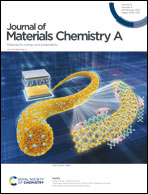Eco-friendly biogenic hydrogel for wearable skin-like iontronics†
Abstract
Traditional wearable devices are mainly fabricated using chemically synthetic organic and inorganic materials, which require high-cost manufacturing processes and consume limited resources, resulting in environmental problems such as electronic waste and plastic pollution. Consequently, sustainable and eco-friendly materials have been considered as potential candidates for fabricating renewable and green human machine interface devices. In this work, we designed wearable skin-like iontronics by using an edible cassava hydrogel to replace unrecoverable sensing components. The prepared capacitive and resistive iontronics can be used to supervise large as well as subtle human motions such as finger bending, micro-expression reading, language recognition and disease monitoring. Moreover, the skin-like hydrogel-based iontronics showed good cyclic repeatability within an appropriate deformation range. In addition, the good film-forming and self-healing properties of the hydrogel and touch sensitivity of the iontronics made it possible to design “artificial skin”. The skin-like iontronics might show great potential in future human–machine interface devices. This work explored the opportunities of an eco-friendly hydrogel in wearable skin-like sensors.



 Please wait while we load your content...
Please wait while we load your content...